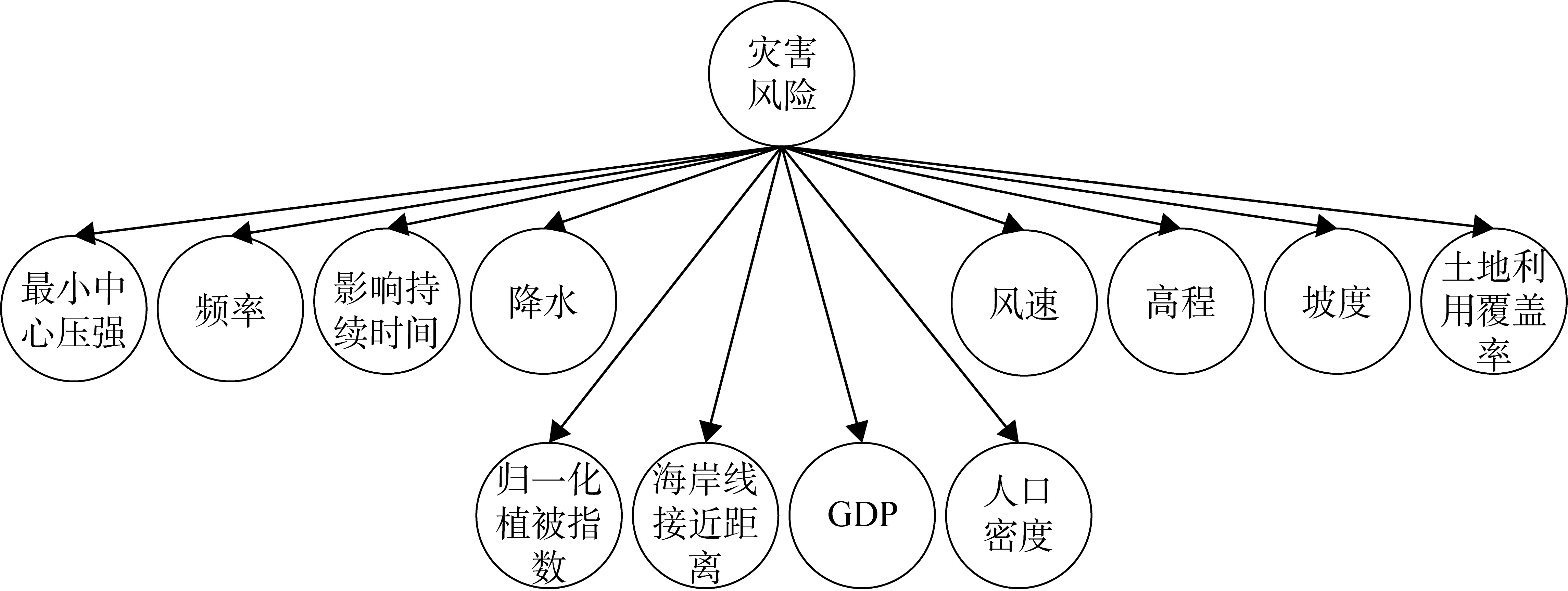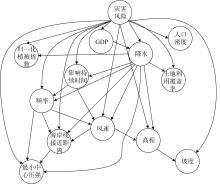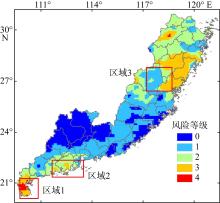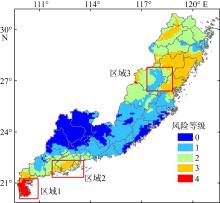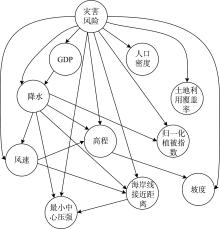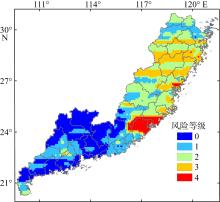Journal of Tropical Oceanography ›› 2023, Vol. 42 ›› Issue (5): 17-29.doi: 10.11978/2022092CSTR: 32234.14.2022092
Special Issue: 全球变化专题
• Marine Meteorology • Previous Articles Next Articles
Assessment of tropical cyclone disaster risk based on the Bayesian network and GIS
TIAN Cheng1( ), LI Xin1(
), LI Xin1( ), DU Yang1, LI Ming1, XIE Yong2, XIA Jilu3
), DU Yang1, LI Ming1, XIE Yong2, XIA Jilu3
- 1. College of Meteorology and Oceanography, National University of Defense Technology, Changsha 410005, China
2. Jiangxi Meteorological Bureau, Nanchang 330008, China
3. 95903 Troop Meteorological Observatory, Wuhan 430000, China
-
Received:2022-04-29Revised:2022-07-12Online:2023-09-10Published:2022-07-19 -
Supported by:National Natural Science Foundation of China(41605051); National Natural Science Foundation of China(41976188); Key Research Program of National University of Defense Technology(ZK17-02-010)
Cite this article
TIAN Cheng, LI Xin, DU Yang, LI Ming, XIE Yong, XIA Jilu. Assessment of tropical cyclone disaster risk based on the Bayesian network and GIS[J].Journal of Tropical Oceanography, 2023, 42(5): 17-29.
share this article
Add to citation manager EndNote|Reference Manager|ProCite|BibTeX|RefWorks
Tab. 2
Discrete indicator data"
| 划分的区域单元格 | 1 | 2 | 3 | 4 | …… | 4039 | 4040 | 4041 |
|---|---|---|---|---|---|---|---|---|
| 最小中心压强 | 1 | 1 | 1 | 2 | …… | 4 | 4 | 4 |
| 频率 | 1 | 1 | 1 | 0 | …… | 4 | 4 | 4 |
| 影响持续时间 | 0 | 0 | 0 | 0 | …… | 2 | 4 | 4 |
| 降水 | 4 | 4 | 4 | 4 | …… | 0 | 0 | 0 |
| 风速 | 2 | 2 | 2 | 2 | …… | 2 | 1 | 2 |
| 高程 | 3 | 4 | 3 | 4 | …… | 3 | 3 | 3 |
| 坡度 | 4 | 4 | 3 | 4 | …… | 3 | 3 | 3 |
| 土地利用覆盖率 | 1 | 3 | 4 | 4 | …… | 3 | 4 | 0 |
| 归一化植被指数 | 2 | 0 | 2 | 3 | …… | 1 | 1 | 1 |
| 海岸线接近距离 | 2 | 2 | 2 | 3 | …… | 4 | 4 | 4 |
| GDP | 4 | 4 | 4 | 4 | …… | 4 | 4 | 4 |
| 人口密度 | 0 | 0 | 0 | 0 | …… | 0 | 0 | 0 |
| 热带气旋灾害风险 | 3 | 3 | 3 | 3 | …… | 2 | 2 | 2 |
Tab. 3
Conditional probability distribution P(Risk|Precipitation) of node precipitation"
| 降水等级 | 灾害风险等级 | ||||
|---|---|---|---|---|---|
| 0 | 1 | 2 | 3 | 4 | |
| 0 | 0.0206 | 0.0995 | 0.0443 | 0.0198 | 0.0000 |
| 1 | 0.1777 | 0.0357 | 0.0521 | 0.0555 | 0.0201 |
| 2 | 0.0985 | 0.0636 | 0.0404 | 0.0047 | 0.0573 |
| 3 | 0.0073 | 0.0675 | 0.0010 | 0.0177 | 0.0417 |
| 4 | 0.0000 | 0.0000 | 0.0000 | 0.0443 | 0.0307 |
Tab. 4
Posterior probability distribution and risk level of tropical cyclone disasters"
| 测试集样本 | 0 | 1 | 2 | 3 | 4 | 评估 风险等级 | 实际 风险等级 |
|---|---|---|---|---|---|---|---|
| 1 | 0 | 0 | 0 | 0.811148 | 0.188852 | 3 | 4 |
| 2 | 0.844427 | 0.155573 | 0 | 0 | 0 | 0 | 0 |
| 3 | 0.862136 | 0.137864 | 0 | 0 | 0 | 0 | 0 |
| 4 | 0 | 0 | 0 | 0 | 1 | 4 | 4 |
| ⋮ | ⋮ | ⋮ | ⋮ | ⋮ | ⋮ | ⋮ | ⋮ |
| 201 | 0 | 0 | 0.029417 | 0.970583 | 0 | 3 | 3 |
| 202 | 1 | 0 | 0 | 0 | 0 | 0 | 0 |
| 203 | 1 | 0 | 0 | 0 | 0 | 0 | 0 |
| [1] |
包文轩, 宫阿都, 徐澯, 等, 2023. 基于区域灾害系统论的广东省台风灾害风险评估——以“山竹”台风为例[J]. 北京师范大学学报(自然科学版), 59(1): 94-103.
|
|
|
|
| [2] |
陈楷俊, 陈艺仪, 陈菁, 2019. 近30年粤东地区台风灾害风险评估与分析[J]. 水土保持研究, 26(3): 362-366, 372.
|
|
|
|
| [3] |
陈香, 2007. 福建省台风灾害时空变化分析[J]. 灾害学, 22(4): 66-70.
|
|
|
|
| [4] |
高歌, 黄大鹏, 赵珊珊, 2019. 基于信息扩散方法的中国台风灾害年月尺度风险评估[J]. 气象, 45(11): 1600-1610.
|
|
|
|
| [5] |
黎鑫, 洪梅, 王博, 等, 2012. 南海-印度洋海域海洋安全灾害评估与风险区划[J]. 热带海洋学报, 31(6): 121-127.
|
|
doi: 10.11978/j.issn.1009-5470.2012.06.019 |
|
| [6] |
李超超, 田军仓, 申若竹, 2020. 洪涝灾害风险评估研究进展[J]. 灾害学, 35(3): 131-136.
|
|
|
|
| [7] |
李明, 张韧, 洪梅, 2018a. 基于加权贝叶斯网络的海洋灾害风险评估[J]. 海洋通报, 37(2): 121-128.
|
|
|
|
| [8] |
李明, 张韧, 洪梅, 等, 2018b. 基于信息流改进的贝叶斯网络结构学习算法[J]. 系统工程与电子技术, 40(6): 1385-1390.
|
|
doi: 10.3969/j.issn.1001-506X.2018.06.28 |
|
| [9] |
刘合香, 卢耀健, 王萌, 等, 2020. 基于信息扩散技术的华南极端台风灾害风险评估[J]. 热带海洋学报, 39(3): 31-41.
doi: 10.11978/2019071 |
|
doi: 10.11978/2019071 |
|
| [10] |
民政部门户网站, 2022.06.17. 国家减灾委、民政部紧急启动国家Ⅳ级救灾应急响应协助福建省做好“莫兰蒂”台风灾害救灾工作[EB/OL]. [2016-09-16]. http://www.ndrcc.org.cn/yjgz/10466.jhtml (in Chinese).
|
| [11] |
潘金兰, 徐庆娟, 刘合香, 2021. 基于AHP-TOPSIS最优组合赋权的台风灾害风险评估[J]. 南宁师范大学学报(自然科学版), 38(1): 60-67.
|
|
|
|
| [12] |
申怀飞, 杨清洁, 魏亿鑫, 等, 2020. 基于GIS的湖南省滑坡灾害风险和损失评估[J]. 水土保持通报, 40(6): 146-152, 329.
|
|
|
|
| [13] |
汤国安, 2019. 地理信息系统教程(第二版)[M]. 北京: 高等教育出版社.
|
|
|
|
| [14] |
王洁, 杨奕杰, 王杰, 等, 2021. 基于近20a历史数据的中国沿海城市台风灾害风险评估[J]. 海洋预报, 38(5): 24-30.
|
|
|
|
| [15] |
王伟, 金贤锋, 2020. 面向国土空间规划的测绘地理信息技术及数据成果服务应用展望[J]. 测绘通报, 12: 58-64.
|
|
|
|
| [16] |
温家洪, 黄蕙, 陈珂, 等, 2012. 基于社区的台风灾害概率风险评估——以上海市杨浦区富禄里居委地区为例[J]. 地理科学, 32(3): 348-355.
doi: 10.13249/j.cnki.sgs.2012.03.348 |
|
|
|
| [17] |
吴斌, 钱业, 王瑞芳, 等, 2021. 全球气候模式对影响西北太平洋台风强度的大尺度环境因子的模拟评估[J]. 干旱气象, 39(3): 466-479.
|
|
|
|
| [18] |
徐庆娟, 潘金兰, 刘合香, 2020. 基于云模型—风险矩阵的华南台风灾害综合等级评估[J]. 气象与减灾研究, 43(3): 161-169.
|
|
|
|
| [19] |
于小兵, 俞显瑞, 吉中会, 等, 2019. 基于信息扩散的东南沿海台风灾害风险评估[J]. 灾害学, 34(1): 73-77.
|
|
|
|
| [20] |
张悦, 李珊珊, 陈灏, 等, 2017. 广东省台风灾害风险综合评估[J]. 热带气象学报, 2017, 33(2): 281-288.
|
|
|
|
| [21] |
周华任, 张晟, 穆松, 等, 2015. 综合评价方法及其军事应用[M]. 北京: 清华大学出版社.
|
|
|
|
| [22] |
朱婧, 陆逸, 李国平, 等, 2017. 基于县级分辨率的福建省台风灾害风险评估[J]. 灾害学, 32(3): 204-209.
|
|
|
|
| [23] |
朱婧, 叶龙彬, 陈德花, 等, 2020. 1614号台风“莫兰蒂”在厦门湾及其周边海域引发风暴潮的数值模拟[J]. 海洋预报, 37(6): 20-30.
|
|
|
|
| [24] |
中国新闻网, 2022.06.17. “莫兰蒂”台风造成浙闽直接经济损失210.73亿元[EB/OL]. http://news.cri.cn/uc-eco/20160918/660ac9c9-c670-1ba3-a8a2-c93667984aab.html (in Chinese).
|
| [25] |
doi: 10.1080/19475705.2020.1753823 |
| [26] |
|
| [27] |
|
| [28] |
|
| [29] |
doi: 10.1142/S0218194014500119 |
| [30] |
doi: 10.3390/su12104212 |
| [31] |
|
| [32] |
doi: 10.1016/j.scitotenv.2019.07.132 |
| [33] |
doi: 10.1007/s10668-018-0086-2 |
| [34] |
doi: 10.1175/2009BAMS2755.1 |
| [35] |
doi: 10.3390/jmse9060640 |
| [36] |
doi: 10.1007/s11802-021-4631-5 |
| [37] |
doi: 10.3390/su13010147 |
| [38] |
doi: 10.3390/su132011507 |
| [39] |
|
| [40] |
doi: 10.3390/geosciences9020058 |
| [41] |
doi: 10.1080/13658810600852230 |
| [42] |
|
| [43] |
doi: 10.1016/j.apm.2011.07.083 |
| [44] |
doi: 10.3390/su10103810 |
| [45] |
doi: 10.1080/19475705.2019.1685010 |
| [46] |
doi: 10.1002/joc.2016.36.issue-4 |
| [47] |
doi: 10.1080/19475705.2017.1362040 |
| [48] |
|
| [1] | WU Hongbo, LUO Feng, CHEN Zhipeng, ZHU Fei, ZENG Jingwei, ZHANG Chi, LI Ruijie. A novel pattern for predicting the effects of mangrove ecological reconstruction [J]. Journal of Tropical Oceanography, 2024, 43(4): 86-97. |
| [2] | DING Yiting, DONG Dibo. Study on comprehensive risk assessment of storm surges for Fujian Province from the perspective of resilience [J]. Journal of Tropical Oceanography, 2024, 43(1): 126-136. |
| [3] | Min ZHANG, Jun LUO, Jinlei HU, Xuezhi ZENG. Inundation risk assessment of storm surge along Lei Zhou coastal areas* [J]. Journal of Tropical Oceanography, 2019, 38(2): 1-12. |
| [4] | Zhishen CHEN, Weiyong SHI, Jianfei LU. Comparative analysis on four recurrence levels of joint distribution of wave height and period* [J]. Journal of Tropical Oceanography, 2018, 37(4): 18-23. |
| [5] | LI Yaping, YAN Qin, LIU Zhengjun, MA Yi. Extraction and variation analysis of Zhaoshu Isle land cover based on high resolution remote sensing images [J]. Journal of Tropical Oceanography, 2016, 35(2): 93-101. |
| [6] | LI Xin, HONG Mei, WANG Bo, ZHANG Ren, GE Shan-shan, QIAN Long-xia. Disaster assessment and risk zoning concerning the South China Sea and Indian Ocean safety [J]. Journal of Tropical Oceanography, 2012, 31(6): 121-127. |
| [7] | WANG Chun-juan,DU De-wen,LIU Yong-gang,ZHU Zhi-wei,YAN Shi-juan,YANG Gang. GIS assessment of potential gas hydrate mineral resources in the Gulf of Mexico based on Weights-of-Evidence modeling [J]. Journal of Tropical Oceanography, 2012, 31(5): 88-92. |
|
||





